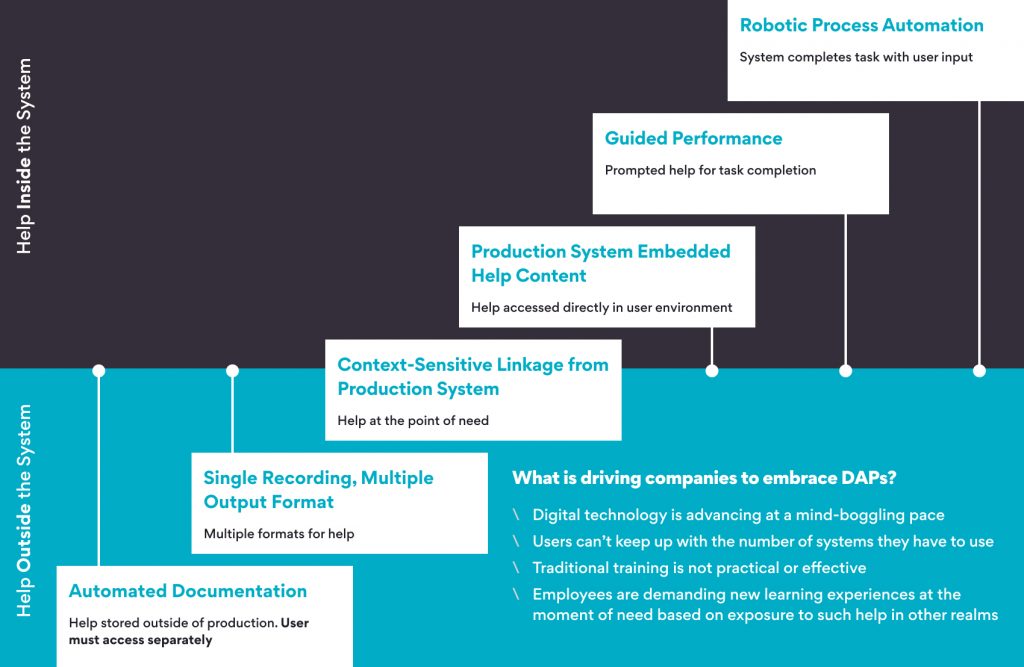User Assistance by using a Digital Adoption Platform
Traditionally, verbose technical documentation, user guides, manuals, online help, and similar artifacts have been critical assets in user assistance. Organizations then and even now need technical documentation to complement and complete the product development and release journey. The big question is, do the end-users spend that much time reading through the long-winded documentation? As an end-user of some software or service, you know the answer.
Technical documentation is a must-have for any software. However, for the content to be effective and valuable, merely packaging it with the software does not help. The content needs to be smart enough to assist when the user needs assistance.
Benefits of Moving to a Digital Adoption Platform (DAP)
Software applications today are increasingly becoming complex, smart, intelligent, and fast-paced. Traditional user assistance in the form of technical documentation is always available as a blessing, but they are mostly ineffective. Frustrated users thus end up looking for solutions on the internet or calling and venting them out to the support representatives. End-users of complex, smart, and intelligent software applications need equally easy and effective user assistance that saves time and solves their problems quickly.
A Digital Adoption is a SaaS-based platform that provides:
- A layer of software that is integrated on top of software applications or websites.
- A framework for content experts to build feature tours, tooltips, overlaid instructions, walkthroughs, interactive guides, learning content, inline documentation, announcements, and more.
Advantages – Timely User Assistance and Happy End-users
Imagine software that uses artificial intelligence (AI) to perform tasks like humans or software that uses machine learning (ML) to predict outcomes. With these dynamics, we cannot expect the end-users to read through user guides or manuals. The user will prefer not to and rather expect real-time user assistance.
For the end-users, the DAP solution provides:
- Guidance through tasks and functions based on needs and preferences
- Handholding for new users
- Smart tips that provide contextual information in real-time for seasoned users
- Behavioral analysis of end-users and tuning user assistance based on observed patterns
- Significant reduction in support calls by directing to the readily available information base

Stakeholders Involved
Approximately five key stakeholders are involved in this solution. The technical content experts are and should be the primary owners of this solution because the content is the core.
- Product Owners/Managers – They serve as the decision-makers to give the go-ahead and invest time and effort to develop an effective user assistance experience for the software.
- Technical Content Developers – A.k.a Technical Writers or Information Developers are the primary drivers of this right from planning, building, writing, implementing, testing, releasing, and maintaining.
- Engineering – They are the go-to technical stakeholders that set up the framework/code base for the content experts to take over and move forward.
- Customer Support – These perhaps play the most crucial role in the journey. Customer support is the pseudo-customer. They know the exact pain points and the needs of the customers.
- UI Experts – They serve as consultants for visual elements such as the look and feel, colors, branding, styles, graphics, logos, and more.
Digital Adoption Platform – Process at a High-level
After the stakeholders decide on the most suitable platform and seal the deal with the platform provider, the high-level process is as follows:
- A block of code, a.k.a snippet, is embedded in the web application by engineering with consultation and assistance from the platform provider. This is a one-time effort.
- This provides a framework for the content experts to build user assistance solutions that function as overlays on the user interface. Content experts use the SaaS-based rapid application development (RAD) user interface to build user assistance artifacts.
- The user assistance artifacts such as product tours, tips, walkthroughs, announcements, and more can be developed, tested, published, and unpublished silently without disrupting the application lifecycle or code base.
Digital Adoption Platforms – Are they worth the investment?
The objective of a Digital Adoption Platform is not merely building user assistance artifacts but also tracking the user behavior, user journey, user engagement, effectiveness of the solution, and analysis closely and adapting it to customer needs and ever-changing business scenarios.
Organizations are very watchful about spending and often skeptical about this move. The most common challenges and questions that product management has to answer are:
- Lack of suitable support articles
- Inadequate documentation
- Lack of real-time tooltips for assistance
- Unclear error messages
- Hidden information and oblivious user
- Disappointing new-user onboarding and training experience
- A large volume of support tickets as the team is loaded with rudimentary doubts
Digital Adoption Platform is built to handle these awkward situations and stress. The USP of this approach is that the engineering team can focus on the core product functionality while the content experts can develop user assistance without having to write any code.
Deciding on the Perfect DAP
There are leading players in the DAP space with compelling solutions, such as Appcues, Pendo, WalkMe, WhatFix, Apty, and many more. Hence, your product needs and the problem that you want to solve should drive the decision and selection of a DAP. The secret − content experts/strategists should partner with the product owners and zero down on a suitable and viable solution regarding features and cost.
Impact on Traditional Documentation
Product documentation is the root and core of a product’s journey. It will be unfair to say that the traditional documentation is impacted or dated. eLearning, Online Help, and User Guides co-exist because their objective is knowledge retention.
With digitization and automation, we need a slice of traditional content to perform swiftly, and that is where a Digital Adoption Platform helps.
Persistent’s Green House – Technical Communication is a center of excellence (CoE) that brings together a team of experienced, technical, and innovative Technical Writers. Together, Persistent can work with you to transform your technical documentation and user assistance experience.






